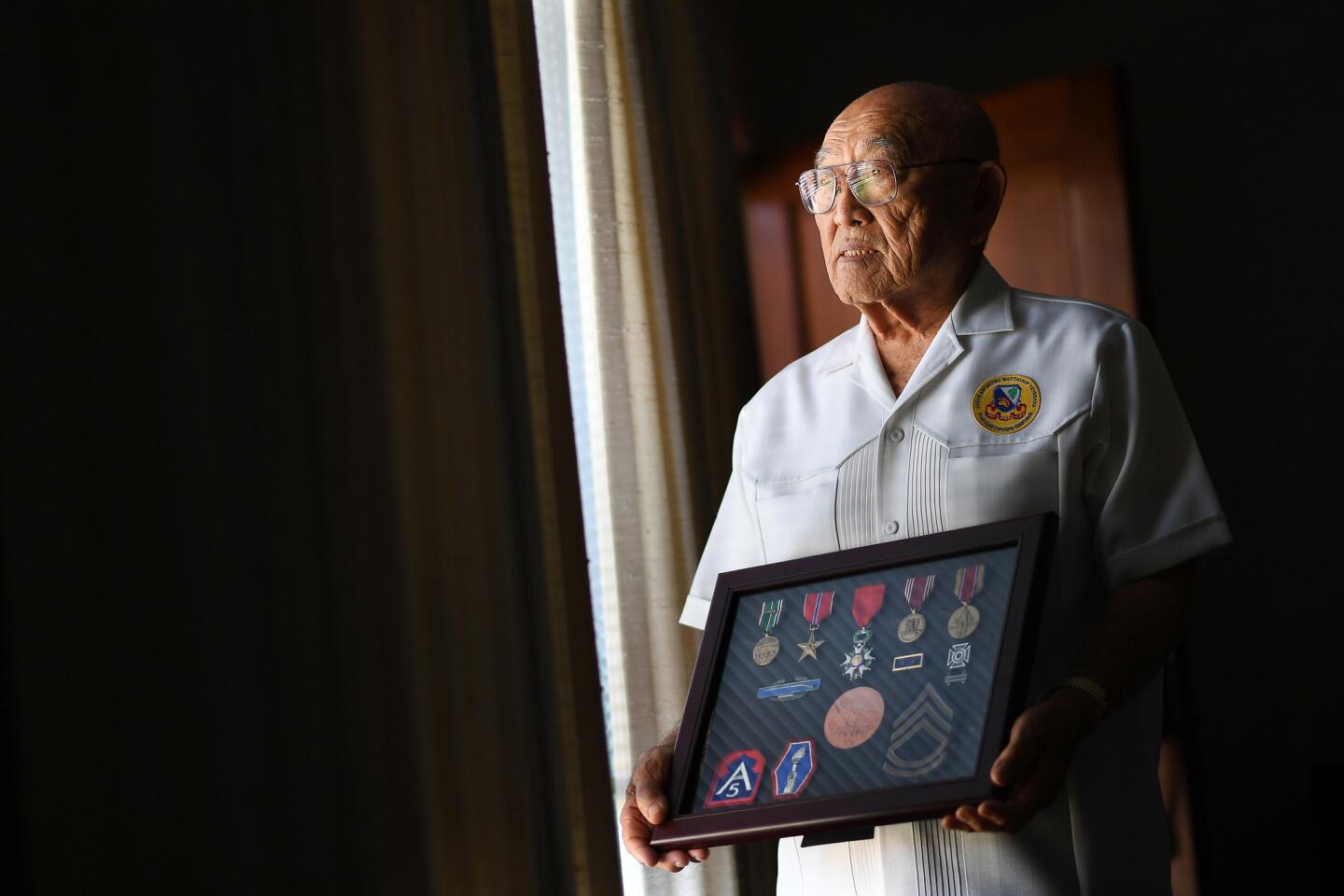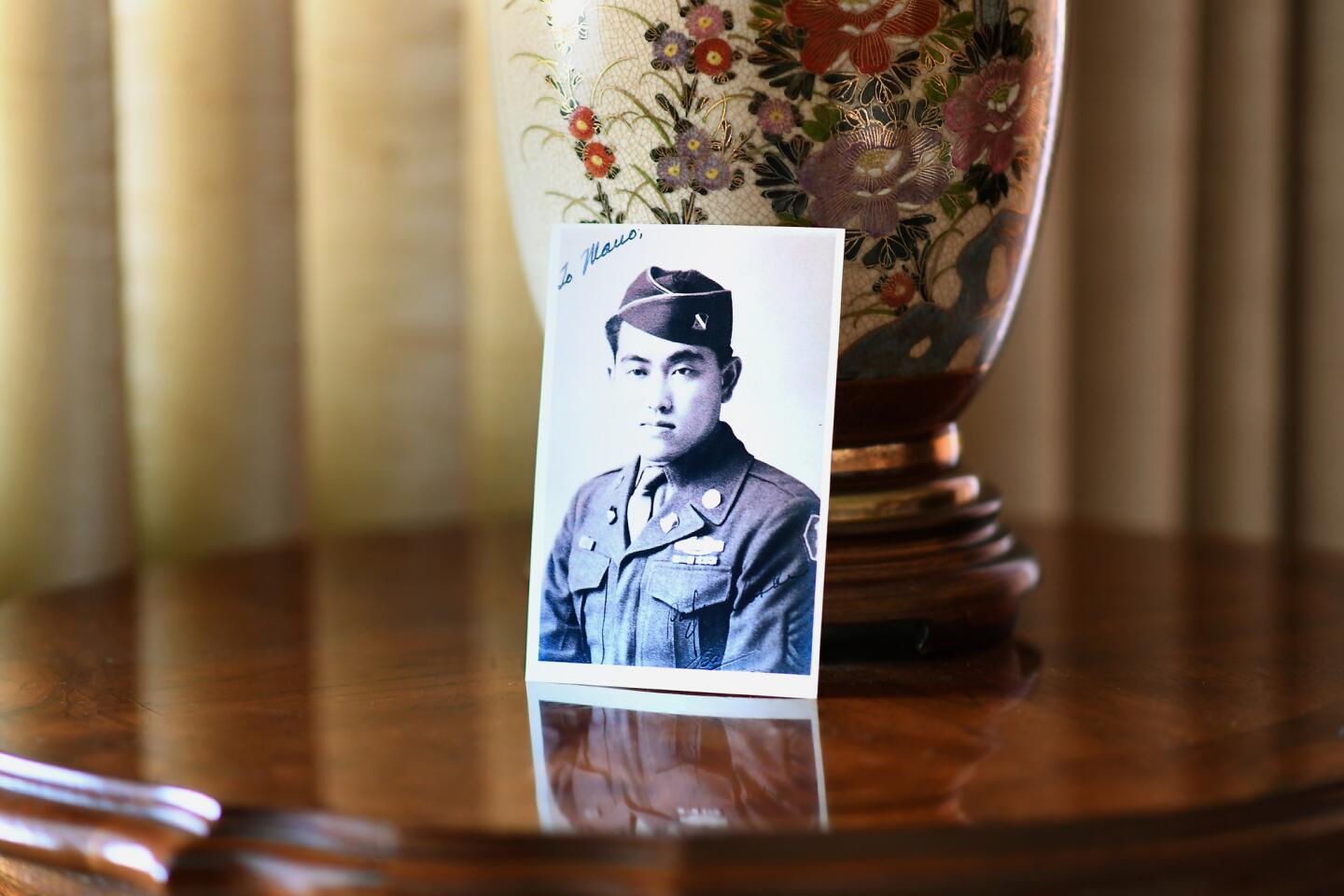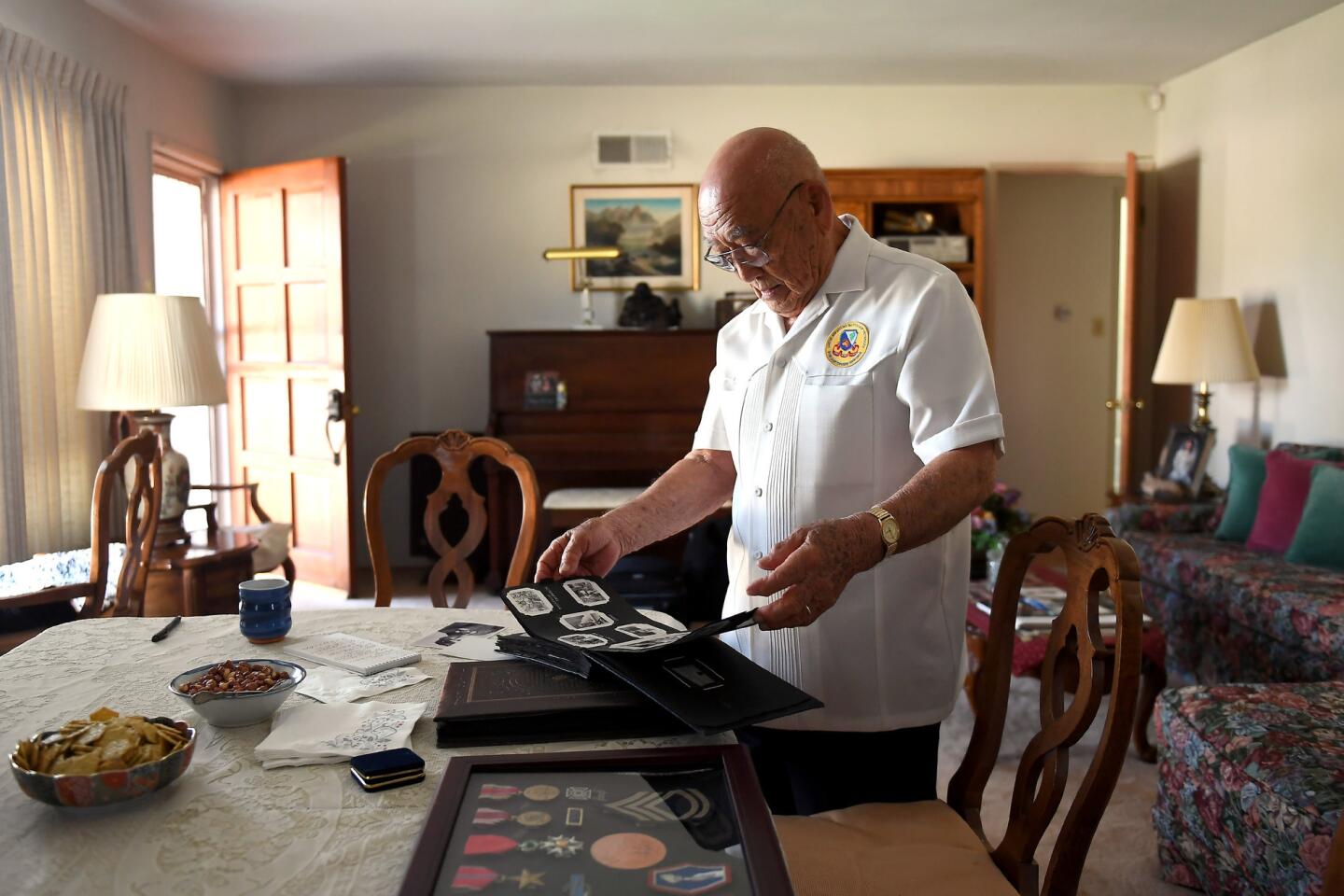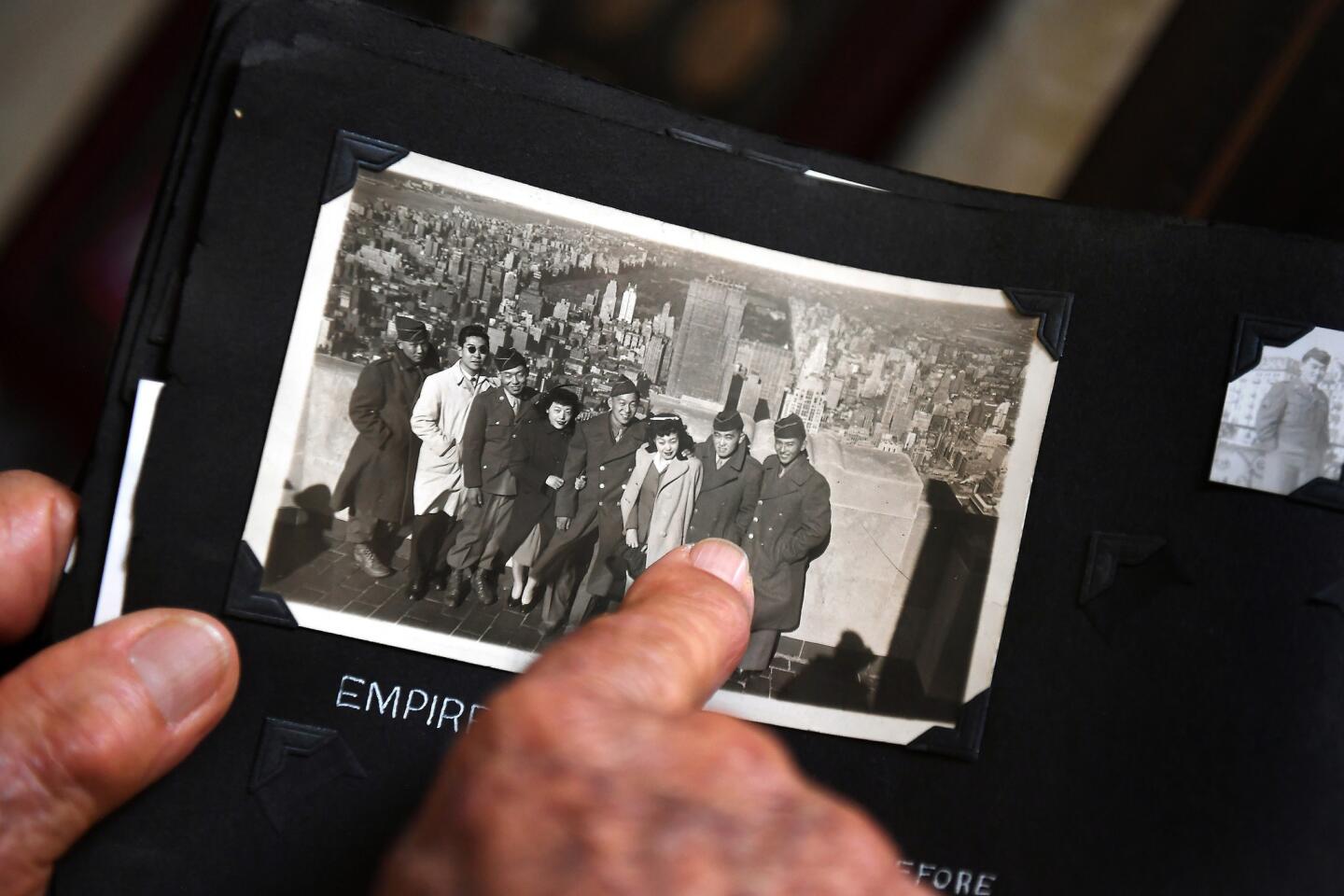A chilling moment to mark the 75th anniversary of the executive order that led to Japanese American internment
- Share via
He’s 94 years old and still clearly remembers.
Tokuji Yoshihashi remembers Japan’s 1941 attack on Pearl Harbor and wondering what would happen to Americans like him who looked like the enemy. He soon found out.
Exactly 75 years ago Sunday, President Franklin D. Roosevelt signed Executive Order 9066, which paved the way for the incarceration of Yoshihashi and 120,000 other Japanese Americans in desolate camps scattered across deserts and swampland. Yoshihashi remembers his anxiety at being locked up and the shock of seeing the barbed wire and armed military guards at his camp in Gila River, Ariz.
He left camp in 1944 to fight for the country he still loved as a member of the U.S. Army’s celebrated 100th Infantry Battalion/442nd Regimental Combat Team, a segregated unit of second-generation Japanese Americans known as Nisei. The battles were brutal — one comrade threw himself on a grenade to protect fellow soldiers in the 1945 fight to break the German Gothic Line in Italy.
But Yoshihashi still remembers, with pride, President Harry S. Truman’s words to his fighting unit: “You fought not only the enemy, but you fought prejudice — and you won.”
Today, however, the aging veteran wonders what his service to safeguard American freedoms and civil rights means at a time of President Trump and his executive order banning the entry of citizens from seven Muslim-majority countries.
“I hope they’re not being wasted,” Yoshihashi said of the veterans’ sacrifices during a recent interview in his San Gabriel home. “That order to ban all the Muslims … I don’t think that’s right.”
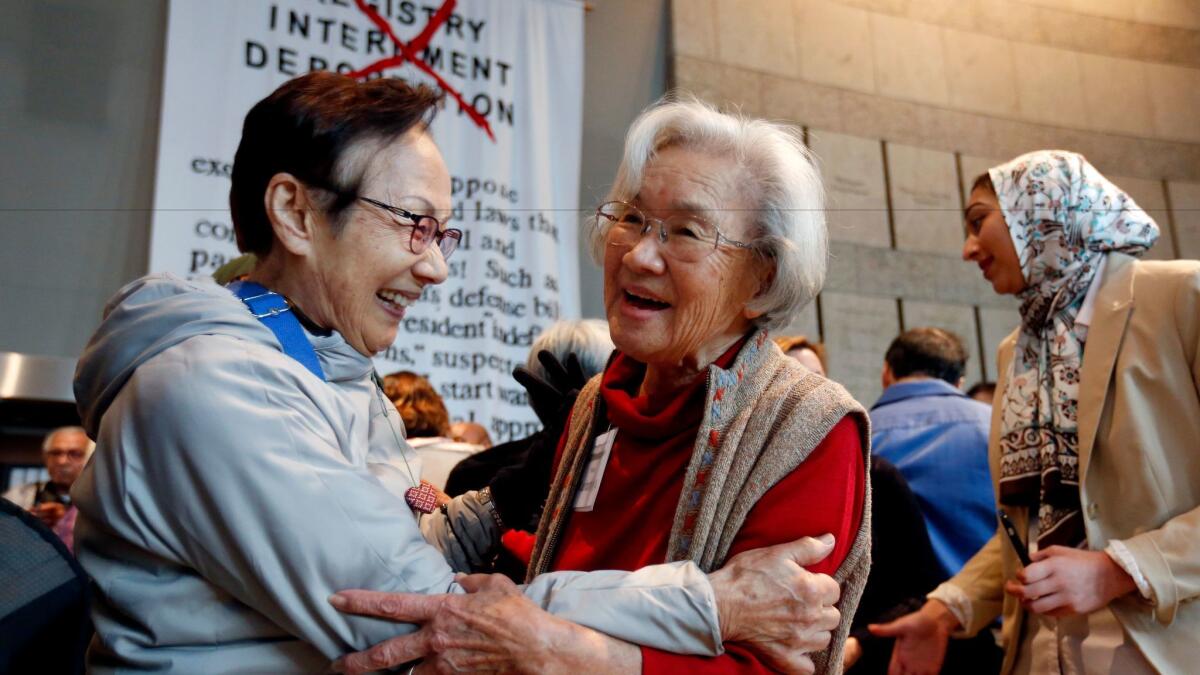
The uneasy parallels between two presidents and two executive orders singling out a class of people were repeatedly invoked Saturday at a packed Little Tokyo forum about the 75th anniversary of the signing of Executive Order 9066.
“As Japanese Americans who were directly affected by incarceration, we have a particular moral obligation to remind people that measures like the Muslim ban are not just unconstitutional, they are un-American,” former U.S. Rep. Norman Mineta said in a statement delivered to the forum. “They … undermine the very thing that sets our country apart: our enduring commitment to freedom and justice for all.”
The forum featured poems, songs and performances, along with remarks from African American, Jewish, Muslim and Latina speakers who connected the Japanese American experience with discrimination against their communities and vowed to fight intolerance together.
The Japanese American National Museum, which hosted the forum with other community groups, opened an exhibit Saturday on Roosevelt’s order and its aftermath, featuring the first display on the West Coast of the actual document bearing the president’s signature.
The exhibit also features copies of the government orders for “all persons of Japanese ancestry” to leave their neighborhoods along the West Coast and in Arizona. A timeline charts the community’s experiences from Pearl Harbor to the closing of the last camp in 1946, including efforts to challenge the constitutionality of the government orders. (The U.S. Supreme Court upheld the orders, but courts three decades ago overturned the convictions of three men who disobeyed them.) Modern art installations include an arresting sculpture of the name tags of those interned.
In 1988, President Ronald Reagan signed a law that offered a formal apology and granted $20,000 in redress payments to surviving camp internees.
The forum and exhibit drew more than 2,000 visitors Saturday — a turnout that stunned museum officials, who set up multiple overflow rooms and still had to turn people away.
You just can’t target a group of people based on race, religion or culture.
— Evan Seki Matsuyama, Oxford University graduate student
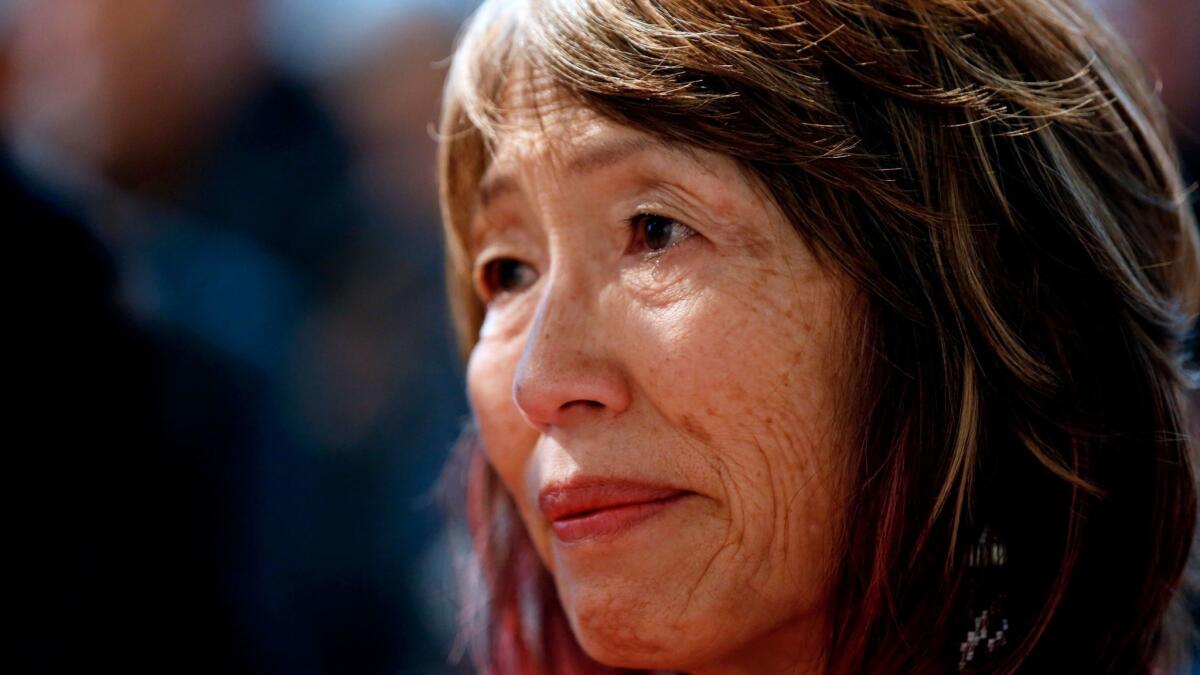
“It’s the confluence of energy” around both the anniversary and Trump’s actions, said Clement Hanami, the museum’s art director. “We’re trying to help people see that in the end, the goal of our society is to really stand up for each other because at any time, it could be something that happens to us.”
Visitors to the forum from across cultures and generations seemed to share that sentiment. Hollis Stewart, a 77-year-old retired computer specialist, said he came to stand for “peace and justice” at a time of growing national divisiveness. He teared up as he recalled his father, a union organizer, taking him to visit the Gila River camp after it closed when he was 12 “so I would understand that these things cannot be allowed.”
“It’s not who we are,” Stewart said.
Leandra Culver and Rachael Stein, both twenty-somethings of Jewish heritage, said the Japanese American experience struck eerie and disturbing parallels with their community’s struggles against anti-Semitism and the current climate of “fear-mongering and unjust actions.”
But they said their generation was confronting intolerance head-on. “Our generation as millennials is incredibly outspoken,” Culver said. “Facebook and Instagram are on fire every second of the day speaking out against the current administration, the Muslim ban and (for) women’s rights.”
Among many Japanese Americans, the impact of Executive Order 9066 is reverberating across generations.
Sumiko Seo Seki was a teenager at the time she and her family were forced to leave their San Pedro farm for incarceration in Jerome, Ark. One of her most vivid memories was her stoic father weeping as he pet his horses goodbye — the first and only time she had ever seen him cry.
The man who would become her husband, Don Seki, lied about his age so he could leave his native Hawaii and join the U.S. Army’s 442nd Regimental Combat Team a year early. He lost his left arm to German machine-gun fire a few days after his unit rescued a Texas infantry division trapped in the Vosges Mountains of France — suffering more than 800 casualties to save 211 lives.
The family experiences have prompted their grandson, Evan Seki Matsuyama, to pursue a doctorate in U.S. history at Oxford University to answer a question he said had long haunted him: “Why did my grandfather lose his arm for a country that put my grandmother in a concentration camp?”
Matsuyama said he hopes his research will honor his grandparents and help prevent history from repeating itself.
“You just can’t target a group of people based on race, religion or culture,” he said.
Mitchell T. Maki, president of a national nonprofit dedicated to education about the history of Japanese American veterans of World War II, said he is optimistic that many Americans have learned those lessons. Although there are parallels between 1942 and 2017, he said, there are also crucial differences.
“America of today is different than the America of ’42,” said Maki, of the Go For Broke National Education Center. “To have people of all races and religions coming together and standing against discriminatory practices is very inspiring.”
He added that the veterans’ sacrifices were hardly wasted, as Yoshihashi wondered. “’They kept freedom and justice alive and it’s incumbent on us to ensure they stay intact for all people.”
Back in San Gabriel, Yoshihashi shared his stories and old photo albums of his childhood and Army days over green tea and rice crackers. He is modest about his framed display of several of his military medals, badges and a copy of the Congressional Gold Medal — the nation’s highest civilian honor — awarded to the Japanese American members of the 100th Infantry Battalion, 442nd Regimental Combat Team and Military Intelligence Service in 2010.
After the war, he joined his family in Ohio for five years and returned to the Los Angeles area in 1951. He started a family, rebuilt engines for the Department of Water and Power and retired at 72.
With characteristic Nisei reticence, he paused when asked what he wanted America to learn on the 75th anniversary of Executive Order 9066.
“That’s tough,” he said, resting his cheek in his hand.
“I’m just glad I went into the service and served my country.”
Twitter: @TeresaWatanabe
ALSO:
California’s Democrats are trying to harness a new wave of progressive energy
Bill Maher’s ‘Real Time’ interview with Milo Yiannopoulos fuels new criticism
Treason! It’s a provocative charge being leveled against Trump, and one that rarely amounts to much
UPDATES:
8:55 a.m.: This article was updated with additional details.
This article was originally published at 5 a.m.
More to Read
Sign up for Essential California
The most important California stories and recommendations in your inbox every morning.
You may occasionally receive promotional content from the Los Angeles Times.
